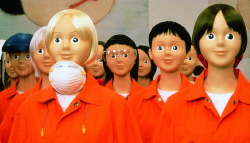Superflat
Museum of Contemporary Art, Los Angeles, USA
Museum of Contemporary Art, Los Angeles, USA

There are two directions an adult can move relative to childhood. You can either try to travel back toward that earlier state on some psychic level, or you can attempt to introduce some quality of youthfulness into latter-day experiences. Both strategies were vividly set in motion through a gamut of media by the 19 Japanese artists represented in 'Superflat'.
Upon entering the exhibition, the viewer was immediately confronted by a phalanx of 33 mannequins which resemble visitors to the adult world marching straight out of everyone's collective youth. Each component of the graphic-design firm groovisions' Chappie 33 (2001) wears a safety-orange jumpsuit and some accessory that indicates adult manual labour: a dust mask, knee-pads, a helmet. At the same time, they all bear the identical wide-eyed stares that signify pre-adolescent naivety. The creature spawned by this cross-breeding seems to represent a labour manager's most cynical desire - an army of mindless idiots ready to do anything they're told, with a smile.
Moving in the other direction was Katsushige Nakahashi's ZERO, Type 52/Los Angeles (2001). This life-size replica of the famous World War II fighter plane is composed of 15,000 colour photographs which scan the surface of an actual Zero, taped together and plumped out with bubble wrap. The resulting facsimile turns a dreaded engine of war into a droopy, toothless shell. Too realistic to be a cartoon, it nevertheless mimics the spooky way cartoons infantilize adult experience through a regression to terms that are always imaginary.
All the work in this eclectic show could be located somewhere between these two poles. With a wave of the media-powered wand of Pop culture, the silliness of childhood and the expanded opportunities of age are joined in a variety of unholy alliances. The magic could be enchanting, though. In Aya Takano's animated videos, for example, fairy-like waifs move through a set of digitized scenarios with all the guilelessness of a kindergarten's costume parade. At the same time, 3 Sexy Girls (2000) in painted porcelain by Bome show an over-endowed Barbie-like figure doing things that little girls aren't supposed to think about.
As a whole, then, the show was an extended meditation on fantasy, which, abetted by electronic media, mutated into escapism, narcissism and auto-eroticism. What qualified the particular species of fantasy being showcased here was the work's relationship to its sources, which are already fantastical: Japanese manga, television spectacle, animated cinema, pornography. If these originals are at a certain remove from the real world, then the steroid-fed versions go into complete disconnection while still remaining linked through resemblance. Perhaps this is what lent them the eerie power of phantoms and phantasmagoria. It soon became apparent, in fact, that in spite of carnivalesque appearances, the substance of this work veers again and again toward morbid themes.
What is A Dream-like Plan for the Thomas-ification of JR Chuo-line Locomotives (2000), is an illustrated plan by Kentaro Takeuma to deter railroad suicides by emblazoning the front of each train with an effigy of Thomas the Tank Engine - the anthropomorphized locomotive of children's book fame. His reasoning is that no amount of psychic pain could be stronger than the embarrassment of death by choo-choo. But if Takeuma leavens the darkness of his observations with humour, at least, Hiro Sugiyama/Enlightenment represents public death as the apotheosis of the individual. His giant digital prints memorialize two people famous for, among other things, having died young: Ayrton Senna was killed in a racing accident; Karen Carpenter succumbed to a long struggle with anorexia nervosa.
Celebrities like these are symbols for the intensity of experience popular culture is expected to deliver. The mandate is to always be 'super' no matter what the cost. Experiencing much of the work in this show was like stretching out a sweet's initial burst of flavour, or a roller-coaster's charge of adrenaline, or a sex show's flush of energy, and sustaining those amped-up feelings at a slower burn against the inevitable let-down that must always follow in one form or another. The nemesis of this culture's high-charged expectations was referred to by the show's intriguing title. It's not two-dimensionality, but the fear of mediocre sensation that risks making life in the world of this art flat.
























